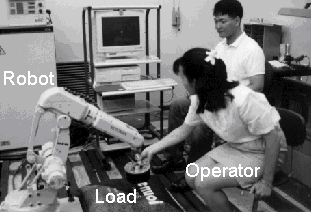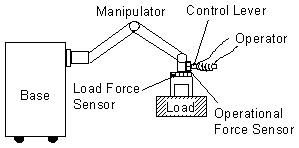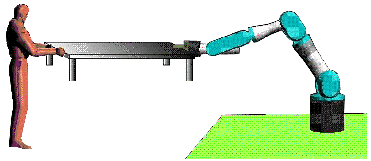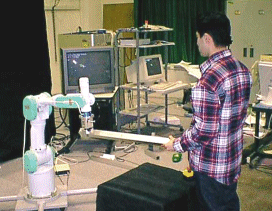Power Assist System
Introduction
Most robots are typically used for simple, repetitive tasks in environments isolated from humans. There is increasing demand for human-friendly robot technologies, with which robots could collaborate with humans sharing the same workspace, to expand robot applications from factory automation into such areas as construction work, shipping services, home and office tasks, etc.
Power assist considering torque saturation
We investigate "Power Assist System" for assisting human force by a robot. The robot arm has two force sensors at the wrist to measure the forces exerted by the human operator and the load. The operator's force is amplified by the joint actuators. In such system, it is a serious problem that the maneuverability and the stability are degraded when the actuators are saturated. To avoid this, we propose to compensate for gravity and dynamic load by different ratios. We experimentally confirmed the validity of the proposed method.(video 1)

Mobile power assist
We also deal with a mobile power assist system, which is a power assist system mounted on a mobile base. It can operate in a larger workspace than a base-fixed system, and has many application fields where human-robot cooperation is needed. We propose a control method for base/arm coordination. It avoids unnecessary movement of the heavy mobile base during operations, while maintaining the manipulator within the safety operating region. To implement this control method, we introduce virtual impedance with a spring component between the base and the manipulator's tip. When the tip position approaches the boundary of the safety region, the operator can feel increasing reflecting force caused by the virtual impedance.(video 2)

Human-robot cooperative manipulation of long object
We also study a robotic assistance system for handling a long object that is difficult to hold for one person. The robot grasps one end of the object and helps the human operator to carry at the other end.
 We propose a control method for cooperative manipulation in a vertical plane, which is inspired by human cooperative behavior. The basic control scheme consists of impedance control in the horizontal movement, free rotation at the robot wrist, and keeping the object horizontal during vertical movement. The operator and robot can equally share the weight of the object.
We propose a control method for cooperative manipulation in a vertical plane, which is inspired by human cooperative behavior. The basic control scheme consists of impedance control in the horizontal movement, free rotation at the robot wrist, and keeping the object horizontal during vertical movement. The operator and robot can equally share the weight of the object.
 For cooperative manipulation in a horizontal plane, we propose a control method using virtual nonholonomic constraint. The movement of the object is constrained as if it were being carried on a wheel attached to the object. This method can prevent the object from slipping sideways and simplify the carrying operation. The operator can easily handle the object just like a wheelbarrow.
For cooperative manipulation in a horizontal plane, we propose a control method using virtual nonholonomic constraint. The movement of the object is constrained as if it were being carried on a wheel attached to the object. This method can prevent the object from slipping sideways and simplify the carrying operation. The operator can easily handle the object just like a wheelbarrow.
(video 3) (video 4)

Research projects
Arai's page






